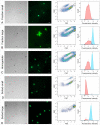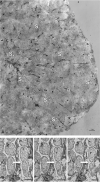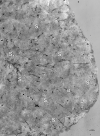Bacterial symbiont subpopulations have different roles in a deep-sea symbiosis
- PMID: 33404502
- PMCID: PMC7787665
- DOI: 10.7554/eLife.58371
Bacterial symbiont subpopulations have different roles in a deep-sea symbiosis
Abstract
The hydrothermal vent tubeworm Riftia pachyptila hosts a single 16S rRNA phylotype of intracellular sulfur-oxidizing symbionts, which vary considerably in cell morphology and exhibit a remarkable degree of physiological diversity and redundancy, even in the same host. To elucidate whether multiple metabolic routes are employed in the same cells or rather in distinct symbiont subpopulations, we enriched symbionts according to cell size by density gradient centrifugation. Metaproteomic analysis, microscopy, and flow cytometry strongly suggest that Riftia symbiont cells of different sizes represent metabolically dissimilar stages of a physiological differentiation process: While small symbionts actively divide and may establish cellular symbiont-host interaction, large symbionts apparently do not divide, but still replicate DNA, leading to DNA endoreduplication. Moreover, in large symbionts, carbon fixation and biomass production seem to be metabolic priorities. We propose that this division of labor between smaller and larger symbionts benefits the productivity of the symbiosis as a whole.
Keywords: Riftia pachyptila; cell differentiation; cell heterogeneity; host-microbe interaction; infectious disease; microbiology; sulfur-oxidizing symbiont; symbiosis.
© 2021, Hinzke et al.
Conflict of interest statement
TH, MK, MM, RS, CH, JP, PH, HF, SS, FB, UV, DB, TS, SM No competing interests declared
Figures














Similar articles
-
Host-Microbe Interactions in the Chemosynthetic Riftia pachyptila Symbiosis.mBio. 2019 Dec 17;10(6):e02243-19. doi: 10.1128/mBio.02243-19. mBio. 2019. PMID: 31848270 Free PMC article.
-
Insights into Symbiont Population Structure among Three Vestimentiferan Tubeworm Host Species at Eastern Pacific Spreading Centers.Appl Environ Microbiol. 2016 Aug 15;82(17):5197-205. doi: 10.1128/AEM.00953-16. Print 2016 Sep 1. Appl Environ Microbiol. 2016. PMID: 27316954 Free PMC article.
-
Endosymbionts of Metazoans Dwelling in the PACManus Hydrothermal Vent: Diversity and Potential Adaptive Features Revealed by Genome Analysis.Appl Environ Microbiol. 2020 Oct 15;86(21):e00815-20. doi: 10.1128/AEM.00815-20. Print 2020 Oct 15. Appl Environ Microbiol. 2020. PMID: 32859597 Free PMC article.
-
Aspects of life development at deep sea hydrothermal vents.FASEB J. 1993 Apr 1;7(6):558-65. doi: 10.1096/fasebj.7.6.8472894. FASEB J. 1993. PMID: 8472894 Review.
-
Chemosynthetic endosymbioses: adaptations to oxic-anoxic interfaces.Trends Microbiol. 2005 Sep;13(9):439-48. doi: 10.1016/j.tim.2005.07.007. Trends Microbiol. 2005. PMID: 16054816 Review.
Cited by
-
The microbiome of the lichen Lobaria pulmonaria varies according to climate on a subcontinental scale.Environ Microbiol Rep. 2024 Jun;16(3):e13289. doi: 10.1111/1758-2229.13289. Environ Microbiol Rep. 2024. PMID: 38923181 Free PMC article.
-
Early genome erosion and internal phage-symbiont-host interaction in the endosymbionts of a cold-seep tubeworm.iScience. 2023 Jun 7;26(7):107033. doi: 10.1016/j.isci.2023.107033. eCollection 2023 Jul 21. iScience. 2023. PMID: 37389180 Free PMC article.
-
How It All Begins: Bacterial Factors Mediating the Colonization of Invertebrate Hosts by Beneficial Symbionts.Microbiol Mol Biol Rev. 2022 Dec 21;86(4):e0012621. doi: 10.1128/mmbr.00126-21. Epub 2022 Oct 27. Microbiol Mol Biol Rev. 2022. PMID: 36301103 Free PMC article. Review.
-
The microbiologist's guide to metaproteomics.Imeta. 2025 May 6;4(3):e70031. doi: 10.1002/imt2.70031. eCollection 2025 Jun. Imeta. 2025. PMID: 40469504 Free PMC article. Review.
-
Current Applications of Absolute Bacterial Quantification in Microbiome Studies and Decision-Making Regarding Different Biological Questions.Microorganisms. 2021 Aug 24;9(9):1797. doi: 10.3390/microorganisms9091797. Microorganisms. 2021. PMID: 34576694 Free PMC article. Review.
References
-
- Barabote RD, Johnson OL, Zetina E, San Francisco SK, Fralick JA, San Francisco MJ. Erwinia chrysanthemi tolC is involved in resistance to antimicrobial plant chemicals and is essential for phytopathogenesis. Journal of Bacteriology. 2003;185:5772–5778. doi: 10.1128/JB.185.19.5772-5778.2003. - DOI - PMC - PubMed
Publication types
MeSH terms
LinkOut - more resources
Full Text Sources
Other Literature Sources

